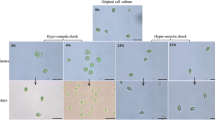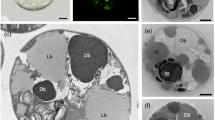Abstract
The effect of sodium pentachlorophenolate (NaPCP) exposure on the nutrient-starved pentachlorophenol (PCP)-mineralizing bacterium Sphingomonas sp. UG30 was assessed using fluorescent methods to measure DNA, RNA, total cellular protein, and cytoplasmic membrane proteins. UG30 cells were inoculated into sterilized Speed River (Guelph, ON, Canada) water samples in the presence of 50, 100, and 250 ppm NaPCP. No marked changes were observed in the total cellular DNA, RNA or protein levels over 90 d, indicating the macromolecular composition of UG30 was not affected by both nutrient limitation and NaPCP. Total cell counts as determined by DAPI staining also did not change over 90 d. Over the same period, viable counts decreased with increasing concentrations of NaPCP. At 250 ppm NaPCP, viable cell counts decreased over 6 orders of magnitude after 1 hr exposure. Cell numbers partially recovered once NaPCP was degraded. The UG30 cytoplasmic membrane polarization ratio also decreased after NaPCP was depleted. The decreased polarization value at the end of the study period suggested the UG30 membrane was more fluid and that this increase in fluidity was due to nutrient starvation effects rather than exposure to NaPCP. These results indicated that UG30 is a robust organism that is able to degrade NaPCP even under adverse conditions and fluorescent methods are useful for determining macromolecular concentrations and cytoplasmic membrane polarization values.
Similar content being viewed by others
References
R. Y. Morita (1992). Low-nutrient environments. in Encyclopedia of Microbiology. Vol. 2, Academic Press, New York, pp. 617–624.
R. Y. Morita (1993). Bioavailability of energy and the starvation state. in S. Kjelleberg (Ed.), Starvation in Bacteria, Plenum Press, New York, pp. 8–16.
R. Y. Morita (1997). Bacteria in Oligotrophic Environments, Starvation-Survival Lifestyle. Chapman & Hall, New York.
F. Schut, R. A. Prins, and J. C. Gottschal (1997). Oligotrophy and pelagic marine bacteria: Facts and fiction. Aquat. Microb. Ecol. 12, 177–202.
P. S. Amy, C. Pauling, and R. Y. Morita (1983). Starvation-survival processes of a marine vibrio. Appl. Environ. Microbiol. 45, 1041–1048.
S. Kjelleberg, N. Albertson, K. Flardh, L. Holmquist, A. Jouper-Jaan, J. Marouga, J. Ostling, B. Svenbald, and D. Weichart (1993). How do non-differentiating bacteria adapt to starvation? Antonie van Leeuwenhoek 63, 333–341.
S. P. Watson, M. O. Clements, and S. J. Foster (1998). Characterization of the starvation-survival response of Staphylococcus aureus. J. Bacteriol. 180, 1750–1758.
A. Muela, I. Arana, J. I. Justo, C. Seco, and I. Barcina (1999). Changes in DNA content and cellular death during a starvation-survival process of Escherichia coli in river water. Microb. Ecol. 37, 62–69.
S. N. Wai, Y. Mizunoe, and S.-I. Yoshida (1999). How Vibrio cholerae survive during starvation. FEMS Microbiol. Lett. 180, 123–131.
J. W. Santo Domingo, S. Harmon, and J. Bennett (2000). Survival of Salmonella species in river water. Curr. Microbiol. 40, 409–417.
A. L. Koch (1971). The adaptive responses of Escherichia coli to a feast and famine existence. Adv. Microb. Physiol. 6, 147–217.
M. O. Clements and S. J. Foster (1998). Starvation recovery of Staphylococcus aureus 8325-4. Microbiol. 144, 1755–1763.
B. D. Davis, S. M. Luger, and P. C. Tai (1986). Role of ribosome degradation in the death of starved Escherichia coli cells. J. Bacteriol. 166, 439–445.
R. G. Groat, J. E. Schultz, E. Zychlinksy, A. Bockman, and A. Matin (1986). Starvation proteins in Escherichia coli: Kinetics of synthesis and role in starvation survival. J. Bacteriol. 168, 486–493.
K. C. Hebert and S. J. Foster (2001). Starvation survival in Listeria monocytogenes: Characterization of the response and the role of known and novel components. Microbiology 147, 2275–2284.
C. A. Reeve, P. S. Amy, and A. Matin (1984). Role of protein synthesis in the survival of carbon-starved Escherichia coli K-12. J. Bacteriol. 160, 1041–1046.
T. Nystrom, K. Flardh, and S. Kjelleberg (1990). Response to multiple-nutrient starvation in marine Vibrio sp. strain CCUG15956. J. Bacteriol. 172, 7085–7097.
K. E. S. Avelar, R. S. Moraes, L. J. F. Pinto, W. das Gracas Silva e Souza, R. M. C. P Domingues, and M. de Souza Ferreira (1998). Influence of stress conditions on Bacteriodes fragilis survival and protein profiles. Zent. bl. Bakteriol. 287, 399–409.
D. E. Jenkins, S. A. Chaisson, and A. Matin (1990). Starvation-induced cross protection against osmotic challenge in Escherichia coli. J. Bacteriol. 172, 2779–2781.
P. Boyaval, E. Boyaval, and M. J. Desmazeaud (1985). Survival of Brevibacterium linens during nutrient starvation and intracellular changes. Arch. Microbiol. 141, 128–132.
J. Garcia-Lara, J. Martinez, M. Vilamu, and J. Vives-Rego (1993). Effects of previous growth conditions on the starvation-survival of Escherichia coli in seawater. J. Gen. Microbiol. 139, 1425–1431.
K. Takayama and S. Kjelleberg (2000). The role of RNA stability during bacterial stress responses and starvation. Environ. Microbiol. 2, 355–365.
S. Kjelleberg, M. Hermansson, P. Marden, and G. W. Jones (1987). The transient phase between growth and nongrowth of heterotrophic bacteria with emphasis on the marine environment. Ann. Rev. Microbiol. 41, 25–49.
J. D. Oliver (1993). Formation of viable but non-culturable cells. in S. Kjelleberg (Ed.), Starvation in Bacteria, Plenum Press, New York, pp. 239–268.
P. A. Jones (1981). Chlorophenols and Their Impurities in the Canadian Environment, En 46-4/81-2. Ottawa, Environment Canada.
D. D. Kaufman (1977). Degradation of pentachlorophenol in soil by soil microorganisms. in K. R. Rao (Ed.), Pentachlorophenol: Chemistry, Pharmacology, and Environmental Toxicology, Plenum Press, New York, pp. 27–39.
D. P. Cirelli (1978). Patterns of pentachlorophenol usage in the United States of America–-an overview. In K. R. Rao (Ed.), Pentachlorophenol: Chemistry, Pharmacology and Environmental Toxicology. Environmental Research 12. Plenum Press, New York, pp. 13–18.
R. C. Doughtery (1977). Human exposure to pentachlorophenol. in K. R. Rao (Ed.), Pentachlorophenol: Chemistry, Pharmacology and Environmental Toxicology, Plenum Press, New York, pp. 351–361.
F. W. Kutz, R. S. Murphy, and S. C. Stassman (1977). Survey of pesticide residues and their metabolites in urine from the general populations. in K. R. Rao (Ed.), Pentachlorophenol: Chemistry, Pharmacology and Environmental Toxicology, Plenum Press, New York, pp. 363–369.
D. G. Crosby (1981). Environmental chemistry of pentachlorophenol. Pure Appl. Chem. 53, 1051–1080.
R. Frank, H. E. Braun, K. I. Stonefield, J. Rasper, and H. Luyken (1990). Organochlorine and organophosphorous residues in the fat of the domestic farm animals species, Ontario, Canada 1986–1988. Food Addit. Contam. 7, 629–636.
C. P. Sandau, P. Ayotte, E. Dewailly, J. Duffe, and R. J. Worstrom (2002). Pentachlorophenol and hydroxylated biphenyl metabolites in umbilical cord plasma of neonates from coastal populations in Quebec. Environ. Health Perspect. 110, 411–417.
L. H. Keith and W. A. Telliard (1979). Priority pollutants I-a perspective view. Environ. Sci. Technol. 13, 416–423.
S. R. Wild, S. J. Harrad, and K. C. Jones (1993). Chlorophenols in digested U.K. sewage sludges. Water Res. 27, 1527–1534.
K. T. Leung, M. B. Cassidy, K. W. Shaw, H. Lee, J. T. Trevors, E.-M. Lohmeier-Vogel, and H. J. Vogel. (1997). Pentachlorophenol biodegradation by Pseudomonas spp. UG25 and UG30. World J. Microbiol. Biotechnol. 13, 305–313.
E. Weinbach (1954). Effect of pentachlorophenol on oxidative phosphorylation. J. Biol. Chem. 210, 545–550.
K. Imai, A. Asano, and R. Sato (1967). Oxidative phosphorylation in Micrococcus denitrificans: I. Prepartion and properties of phosphorylation membrane fragments. Biochem. Biophys. Acta 143, 462–476.
E. M. Lohmeier-Vogel, K. T. Leung, H. Lee, J. T. Trevors, and H. J. Vogel (2001). Phosphorous-31 nuclear magnetic resonance study of the effect of pentachlorophenol (PCP) on the physiologies of PCP-degrading microorganism. Appl. Environ. Microbiol. 67, 3549–3356.
M. Sinensky (1974). Homeoviscous adaptation: A homeostatic process that regulates the viscosity of membrane lipids in Escherichia coli. Proc. Natl. Acad. Sci. USA 71, 522–525.
T. J. Denich, M. B. Cassidy, L. A. Beaudette, H. Lee, and J. T. Trevors (2003). Membrane fluidity of the pentachlorophenol-mineralizing Sphingomonas sp. UG30. J. Fluorescence 13, 385–391.
M. Shinitzky and Y. Barenholz (1978). Fluidity parameters determined by fluorescence polarization. Biochim. Biophys. Acta. 515, 367–394.
B. J. Litman and Y. Barenholz (1982). Fluorescent probe: Diphenylhexatriene. Methods Enzymol. 81, 678–685.
V. Borenstain and Y. Barenholz (1993). Characterization of liposomes and other lipid assemblies by multiprobe fluorescence polarization. Chem. Phys. Lipids. 64, 117–127.
J. R. Lakowicz (1983). Principles of Fluorescence Spectroscopy. Plenum Press, New York.
M. Adler and T. R. Tritton (1988). Flourescence depolarization measurements in oriented membranes. Biophys. J. 53, 989–1005.
M. C. Antunes-Madeira and V. M. C. Madeira (1989). Membrane fluidity as affected by the insecticide lindane. Biochim. Biophys. Acta. 982, 161–166.
M. C. Antunes-Madeira, R. A. Videira, and V. M. C. Madeira (1994). Effects of parathion on membrane organization and its implications for the mechanisms of toxicity. Biochim. Biophys. Acta. 1190, 149–154.
M. Sasser (1990). MIDI Technical Note 101: Identification of Bacteria by Gas Chromatography of Cellular Fatty Acids. MIDI, Newark, DE.
I. S. Kim, H. Lee, and J. T. Trevors (2002). Alterations in the fatty acid composition and fluidity of cell membranes affect the accumulation of PCB congener 2,2′,5,5′-tetrachlorobiphenyl by Ralstonia eutropha H850. J. Chem. Technol. Biotechnol. 77, 793–799.
M. B. Cassidy, K. T. Leung, H. Lee, and J. T. Trevors (2000). A comparison of enumeration methods for culturable Pseudomonas fluorescens cells marked with green fluorescent protein. J. Microbiol. Methods. 40, 135–145.
J. Gallant and S. R. Suskind (1961). Relationship between thymineless death and ultraviolet inactivation in Escherichia coli. J. Bacteriol. 82, 187–194.
M. B. Habash, L. A. Beaudette, M. B. Cassidy, H. J. Vogel, J. T. Trevors, and H. Lee (2002). Cloning and characterization of a tetrachlorohydroquinone reductive dehalogenase from Sphingomonas sp. UG30. Biochem. Biophys. Res. Comm. 299, 634–640.
D. H. Siegele and R. Kolter (1992). Life after log. J. Bacteriol. 174, 345–348.
F. Fegatella and R. Cavicchioli (2000). Physiological responses to starvation in the marine oligotrophic ultramicrobaterium Sphingomonas sp. strain RB2256. Appl. Environ. Microbiol. 55, 2037–2044.
M. A. Hood, J. B. Guckert, D. C. White, and F. Deck (1986). Effect of nutrient deprivation of lipid, carbohydrate, DNA, RNA and protein levels in Vibrio cholerae. Appl. Environ. Microbiol. 52, 788–793.
E. Galdiereo, G. Donnarumma, L. de-Martino, A. Marcatili, G. C. de-l’Ero, and A. Merone (1994). Effect of low-nutrient seawater on morphology, chemical composition and virulence of Salmonella typhimurium. Arch. Microbiol. 162, 41–47.
T. J. Denich, L. A. Beaudette, H. Lee, and J. T. Trevors, (2003). Effect of selected environmental and physico-chemical factors on bacterial cytoplasmic membranes. J. Microbiol. Methods 52, 149–182.
Author information
Authors and Affiliations
Corresponding authors
Rights and permissions
About this article
Cite this article
Denich, T.J., Beaudette, L.A., Lee, H. et al. Fluorescent Methods to Study DNA, RNA, Proteins and Cytoplasmic Membrane Polarization in the Pentachlorophenol-Mineralizing Bacterium Sphingomonas sp. UG30 During Nutrient Starvation in Water. J Fluoresc 15, 143–151 (2005). https://doi.org/10.1007/s10895-005-2522-6
Received:
Accepted:
Issue Date:
DOI: https://doi.org/10.1007/s10895-005-2522-6




